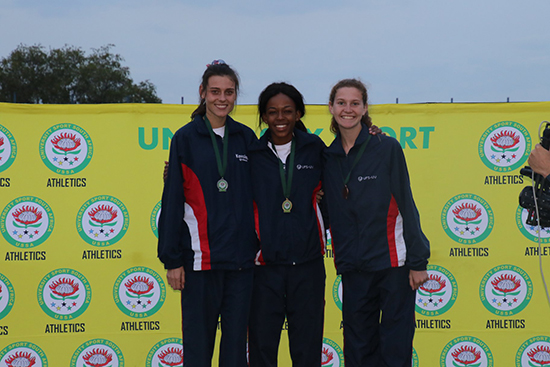Latest News Archive
Please select Category, Year, and then Month to display items
04 May 2018
Photo Facebook
 From left: Marné Mentz (second), Ts’epang Sello (first) and Tyler Beling (third) were in a class of their own, taking the first three spots in the 1 500m at the University Sport South Africa national championship in Sasolburg.
From left: Marné Mentz (second), Ts’epang Sello (first) and Tyler Beling (third) were in a class of their own, taking the first three spots in the 1 500m at the University Sport South Africa national championship in Sasolburg.
As expected, the Kovsie athletics team made the University Sport South Africa (USSA) national championship, held over the weekend in Sasolburg, one to remember.
Eight athletes earned gold medals, which is twice as many as last year. The total of 24 medals (including seven silver and nine bronze) is also double the number won in 2017.
They ended third, just one gold medal below the University of Johannesburg. The female athletes won the women’s competition and contributed to seven of the eight gold medals. The Kovsies dominated the 1 500m and 5 000m events in which they both claimed the first, second and third spots. They even grabbed the fourth and sixth position in the 5 000m in which Kesa Molotsane triumphed, with Tyler Beling second, and Marné Mentz third. Mentz and Beling swapped places in the 1 500m behind Ts’epang Sello.
Molotsane also won the 10 000m in a record time of 34:49.16 which is a massive three minutes and five seconds quicker than the previous record.
The 800m title also now belongs to Sello. She and Beling won a third medal (bronze) as members of the 4 x 400m relay women’s team.
The other gold medalist was Lara Orrock (3 000m steeplechase), Lynique Beneke (long jump), Esli Lamley (pole vault) and Rynardt van Rensburg (800m).
All five Kovsies who competed at the CAA Southern Region Youth & Junior Championships that took place over the weekend in Boksburg, won medals. They were Pakiso Mthembu (gold, 5 000m), Michaéla Wright (gold, long jump), Tyler (gold, 1 500m), Tsebo Matsoso (silver, 200m) and Orrock (silver, 3 000m steeplechase).
Photo manipulation in journalism: evil, crutch or lifebuoy?
2017-09-04

Albe Grobbelaar, veteran journalist and lecturer in the
Department of Communication Science at the UFS.
Photo: Rulanzen Martin
Since the 1800s the manipulation of photographs has been common practice, and who can forget the OJ Simpson Time magazine cover in 1994? Albe Grobbelaar, lecturer in the Department of Communication Science at the University of the Free State (UFS), asked in a special lecture on 18 August 2017 whether “Photo manipulation in Journalism” was an evil habit, a crutch or a lifebuoy.
“As a journalist I have always been interested in photography. And the principle of photo manipulation or tampering with photos, as we call it, is something that has interested me ever since,” Grobbelaar said. Photo manipulation is an area that has garnered many academic interest and is not a new trend but a practice that started in the 1830s when photos came into popular use. “It is not always done with ulterior motives, artists played with photographs to get unique effects.” Photo manipulation is not only to create fake news, but is sometimes used to convey novelty and create shock to news readers.
Different viewpoints for different circumstances
He talked about the spectrum of viewpoints on photo manipulation. Some conservative journalism schools say photos should never be retouched while other feel it is fine to tamper with pictures. “What I tried to convey in the lecture was that one should consider different circumstances differently,” Grobbelaar said. As a journalist he believes that news photos should never be manipulated.
He mentioned the example of the mugshot of OJ Simpson that the Los Angeles Police Department released to the media. “Newsweek and Time both used the photo on their front pages, but Time deliberately darkened the picture so that OJ, a black man, would appear more sinister,” Grobbelaar said. It is, however, common practice in the fashion industry to retouch images that are used in fashion magazines.
Use own judgment to validate photos
In the age of social media it has become easy to manipulate photos and which has been labelled fake news. “I would advise people to use their own judgment when validating the authenticity of photos,” Grobbelaar said. It is important to verify whether they are from a reliable news outlet.